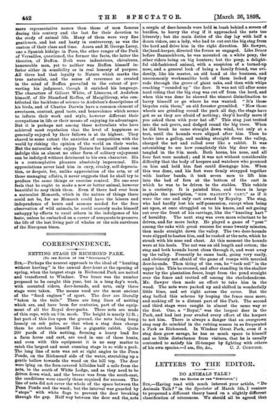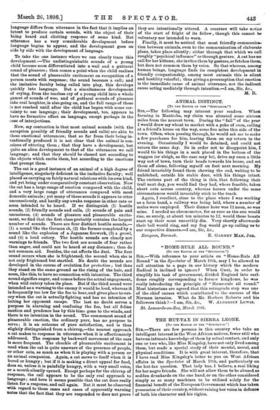LETTERS TO THE EDITOR.
DO ANIMALS TALK?
go THE EDITOR OF THE " SPRCTATOR.") Sis,—Having read with much interest your article, "Do Animals Talk ?" in the Spectator of March 5th, I venture to propound a different theory based on a slightly different classification of utterances. We should all be agreed that
language differs from utterance in the fact that it implies an intent to produce certain sounds, with the object of their being heard and eliciting response of some kind. But utterance has a very considerable development before language begins to appear, and the development goes on side by side with the development of language.
To take the one instance where we can clearly trace this development :—The undiatinguishable sounds of a young child become soon differentiated into a wail and a guttural sound of pleasure ; then comes a point when the child realises that the sound of pleasurable excitement on recognition of a person meets with response; the sound becomes a call; and the imitative faculty being called into play, this develops quickly into language. But a simultaneous development of crying, from the tearless cry of a young child into a whole gamut of sounds of woe, and of guttural sounds of pleasure into real laughter, is also going on, and the full range of these is not reached until after the child has begun with some cer- tainty to use language ; their development, too, appears to have no formative effect on language, except perhaps in the zase of interjections.
Now, my contention is that most animal sounds (with the exception possibly of friendly sounds and calls) are akin to these emotional utterances; that so far from their being in- tentionally produced it is not clear that the animal is con- scious of uttering them ; that they have a development, but quite an alien development to that of the utterances we call language ; and that they should be classed not according to • the objects which excite them, but according to the emotions that prompt them.
The cat is a good instance of an animal of a high degree of intelligence, singularly deficient in the imitative faculty ; well placed as carrying on fairly natural relations with its own kind, and yet being under comparatively constant observation. Now the cat has a large range of emotion compared with the child, and a very large range of utterances compared with most domestic animals ; yet many of these sounds it appears to utter unconsciously, and hardly any awake response in other cats or seem intended to be heard. If we distinguish (1) hostile Bounds, (2) friendly sounds and calls, (3) sounds of pain and uneasiness, (4) sounds of pleasure and pleasurable excite- ment, we find that the first class probably contains the largest number of sounds. There are four distinct hostile sounds,— (1) a sound like the German ch., (2) the former completed by a sound like the explosion of a Japanese firework, (3) a growl, and (4) a loud outcry. The hostile sounds are clearly not warnings to friends. The two first are sounds of fear rather than anger, and could not be heard at any distance ; thus do not summon aid. Besides, the cat affects the duel. The first sound occurs when she is frightened, the second when she is not only frightened but startled. No doubt the sounds are developed in the course of evolution for protection ; but thus they stand on the same ground as the rising of the hair, and seem, like this, to have no connection with intention. The third sound signifies anger, and comes before the actual engagement, when wild outcry takes its place. But if the third sound were intended as a warning to the enemy it would be loud, whereas it is frequently too low for the foe to hear, and gives place to out- cry when the cat is actually fighting and has no intention of letting her opponent escape. The last no doubt serves a purpose in alarming and confusing the foe, bat all feline caution and prudence has by this time gone to the winds, and there is no intention in the sound. The commonest sound of pleasurable emotion, the ordinary purr, has no purpose to serve ; it is an outcome of pure satisfaction, and is thus slightly distinguished from a chirrup,—the nearest approach a cat makes to response in utterance when it is affectionately addressed. The response by backward movement of the ears is more frequent. The chuckle of pleasurable excitement is used when the cat is quite unaware of the presence of people, or other cats, as much as when it is playing with a person or an animal companion. Again, a cat mews to itself when it is bored or hungry ; but if it is making a direct appeal for food, does so, unless it is painfully hungry, with a very small voice, or a mouth silently opened. Except perhaps for the chirrup of response, the call appears to be the only real approach to language ; and here it seems possible that the cat does really listen for a response, and call again. But it must be observed with regard to these cases and cases of apparently warning notes that the fact that they are responded to does not prove
they are intentionally uttered. A creature will take notice of the start of fright of its fellow, though this cannot be voluntary nor intended to warn.
Finally, it must be noticed that most friendly communica- tion between animals, even to the communication of elaborate plans, takes place silently; either through that which we call roughly "psychical influence" or through gesture. A cat has no call for her kittens; she invites them by gesture, or fetches them, but does not summon them by voice. So that whereas, among human beings, language finds its completest development in friendly companionship, among most animals this is silent and hostility voiceful ; thus giving a presumption that emotion is the immediate cause of animal utterance, not the indirect cause acting mediately through intention.—I am, Sir, &c.,
M. B.







































 Previous page
Previous page